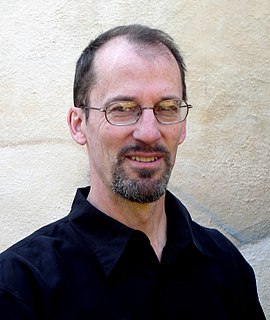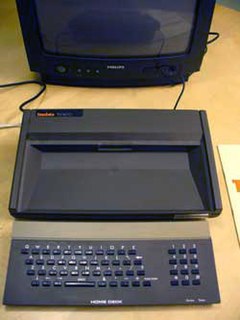
The Defense Advanced Research Projects Agency (DARPA) is a research and development agency of the United States Department of Defense responsible for the development of emerging technologies for use by the military.
Interoperability is a characteristic of a product or system to work with other products or systems. While the term was initially defined for information technology or systems engineering services to allow for information exchange, a broader definition takes into account social, political, and organizational factors that impact system-to-system performance.
Speech synthesis is the artificial production of human speech. A computer system used for this purpose is called a speech computer or speech synthesizer, and can be implemented in software or hardware products. A text-to-speech (TTS) system converts normal language text into speech; other systems render symbolic linguistic representations like phonetic transcriptions into speech. The reverse process is speech recognition.
A domain-specific language (DSL) is a computer language specialized to a particular application domain. This is in contrast to a general-purpose language (GPL), which is broadly applicable across domains. There are a wide variety of DSLs, ranging from widely used languages for common domains, such as HTML for web pages, down to languages used by only one or a few pieces of software, such as MUSH soft code. DSLs can be further subdivided by the kind of language, and include domain-specific markup languages, domain-specific modeling languages, and domain-specific programming languages. Special-purpose computer languages have always existed in the computer age, but the term "domain-specific language" has become more popular due to the rise of domain-specific modeling. Simpler DSLs, particularly ones used by a single application, are sometimes informally called mini-languages.

The Department of Computer Science is one of nine departments in the University of the Philippines Diliman College of Engineering.

David Pope Anderson is an American research scientist at the Space Sciences Laboratory, at the University of California, Berkeley, and an adjunct professor of computer science at the University of Houston. Anderson leads the SETI@home, BOINC, Bossa and Bolt software projects.
The Earth System Modeling Framework (ESMF) is open-source software for building climate, numerical weather prediction, data assimilation, and other Earth science software applications. These applications are computationally demanding and usually run on supercomputers. The ESMF is considered a technical layer, integrated into a sophisticated common modeling infrastructure for interoperability. Other aspects of interoperability and shared infrastructure include: common experimental protocols, common analytic methods, common documentation standards for data and data provenance, shared workflow, and shared model components.

Integration DEFinition for information modeling (IDEF1X) is a data modeling language for the development of semantic data models. IDEF1X is used to produce a graphical information model which represents the structure and semantics of information within an environment or system.

MapWindow GIS is a lightweight open-source GIS (mapping) desktop application and set of programmable mapping components.
The United States Department of Defense High Performance Computing Modernization Program (HPCMP) was initiated in 1992 in response to Congressional direction to modernize the Department of Defense (DoD) laboratories’ high performance computing capabilities. The HPCMP provides supercomputers, a national research network, high-end software tools, a secure environment, and computational science experts that together enable the Defense laboratories and test centers to conduct research, development, test and technology evaluation activities.
Within computing, the Rosetta system-level specification language is a design language for complex, heterogeneous systems. Specific language design objectives include:
Automata-based programming is a programming technology. Its defining characteristic is the use of finite state machines to describe program behavior. The transition graphs of state machines are used in all stages of software development. Automata-based programming technology was introduced by Anatoly Shalyto in 1991. Switch-technology was developed to support automata-based programming. Automata-based programming is considered to be rather general purpose program development methodology than just another one finite state machine implementation.
Handwriting movement analysis is the study and analysis of the movements involved in handwriting and drawing. It forms an important part of graphonomics, which became established after the "International Workshop on Handwriting Movement Analysis" in 1982 in Nijmegen, The Netherlands. It would become the first of a continuing series of International Graphonomics Conferences. The first graphonomics milestone was Thomassen, Keuss, Van Galen, Grootveld (1983).

A virtual learning environment (VLE) is a system that creates an environment designed to facilitate teachers' management of educational courses for their students, especially a system using computer hardware and software, which involves distance learning. In North America, a virtual learning environment is often referred to as a "learning management system" (LMS).
Lynn Gref is a technologist and systems engineer, who has done pioneering work in missile systems; command, control and communications (C3) systems; and satellite systems. He and Dr. William Spuck developed the Rapid Development Methodology (RDM) that was employed in the development of a number of C3 systems for the U.S. Department of Defense. RDM is a form of software development classified as iterative and incremental development. A primary distinction of RDM is that the user is left with a usable capability at the end of every iteration. He pioneered the development of C3 systems using the Ada programming language. He has coauthored a number of reports as a member the Army Science Board (ASB) and as a committee member for the Naval Studies Board of the United States National Academy of Sciences.
MLDesigner is an integrated modeling and simulation tool for the design and analysis of complex embedded and networked systems. MLDesigner speeds up modeling, simulation and analysis of discrete event, discrete time and continuous time systems concerning architecture, function and performance. The tools is based on ideas of the "Ptolemy Project", done at the University if California Berkeley. MLDesigner is developed by MLDesign Technologies Inc. Palo Alto, CA, USA in collaboration with Mission Level Design GmbH, Ilmenau, Germany.
SIGNAL is a programming language based on synchronized data-flow : a process is a set of equations on elementary flows describing both data and control.

Apache cTAKES: clinical Text Analysis and Knowledge Extraction System is an open-source Natural Language Processing (NLP) system that extracts clinical information from electronic health record unstructured text. It processes clinical notes, identifying types of clinical named entities — drugs, diseases/disorders, signs/symptoms, anatomical sites and procedures. Each named entity has attributes for the text span, the ontology mapping code, context, and negated/not negated.
Aquaveo is a modeling software company based in Provo, Utah that develops software used to model and simulate groundwater, watershed, and surface water resources. Its main software products include SMS, GMS, WMS, and Arc Hydro Groundwater.
The service-oriented computing environment (SORCER) is a distributed computing platform implemented in Java. It allows writing network-programs that operate on wrapped applications (services) to spread across the network. SORCER is often utilized in scenarios similar to those where grids are used in order to run parallel tasks.






